Archive for the 'Les Garagistes' Category
Next up: Grenache and Viognier on Saturday
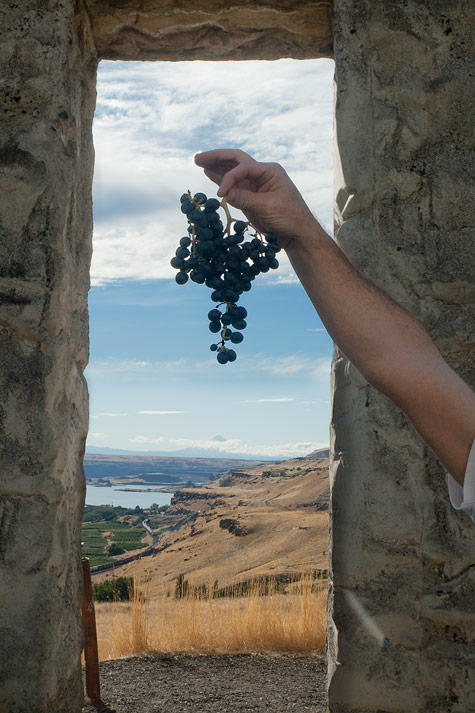 Just as the syrah and merlot from last weekend are starting to think about fermenting, we’re off to Eastern Washington to fetch the next Garagiste candidates: Grenache and Viognier. The weather looks like it will hold both here and there, so here’s hoping for both flavor and favor at the vineyard
Just as the syrah and merlot from last weekend are starting to think about fermenting, we’re off to Eastern Washington to fetch the next Garagiste candidates: Grenache and Viognier. The weather looks like it will hold both here and there, so here’s hoping for both flavor and favor at the vineyard
Dare I say it out loud?
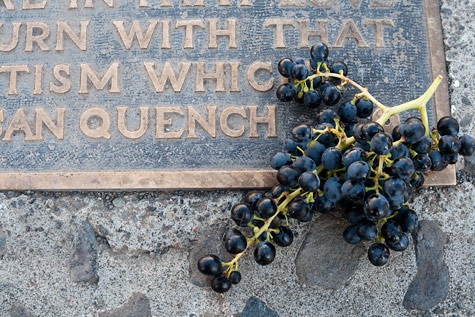 Okay, I will, but sotto voce: so far, so good.
Okay, I will, but sotto voce: so far, so good.
2011 is shaping up to be a tough vintage for everyone in the Northwest, but you wouldn’t know it from the two grapes we picked up over the weekend. Last Saturday, James and I had an extremely pleasant — and more importantly, rain-free — road trip out to Elephant Mountain to pick up Syrah and Merlot. Denis, the vineyard manager, had been gently lowering expectations leading up to harvest, but the fruit we tasted as we walked through the vineyard with him was supreme.
And back in the winery, the numbers matched: 25.5 brix and 3.43 pH for the Syrah, and 25/3.39 for the Merlot. Great depth of flavor, nice acidity (reflected in the lower pH), ripe but not jammy. Considering the tales we’ve been hearing from our winemaking brothers and sisters in the Willamette Valley — nightmarish tales of grapes stalled a few brix short of the finish line of pickability — we’re incredibly lucky.
Back at the winery, a small but experienced crew gathered and we took care of the fruit in short order. We’d done a little R&D on the crusher/destemmer to adjust its rollers (the part that should crack the berries, but not smash them), and I think we found a setting that, at least for these two grapes, gave us mostly happy, rolling grapes out the other end.
Next weekend, it’ll be Viognier and perhaps Tempranillo and Grenache. Here’s hoping for a copy/paste of this past weekend…
No commentsVintage 2011 Begins!
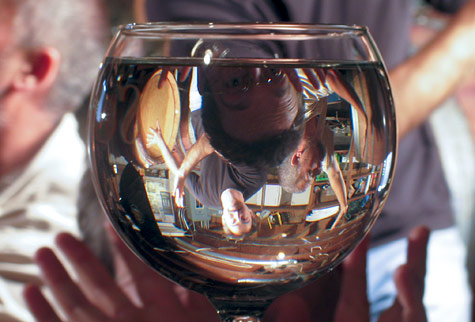
Just about to head out the Gorge with James to round up the first grapes of the season: syrah and merlot, about 3/4 ton all told.
Because of the resolutely crappy weather this spring and summer, this vintage promises to be a wild ride, so I’m wondering for the first time in years what we’ll find when we walk the vineyard four hours from now. Luckily, we’ll be doing it with Denis Gayte, the seasoned and savvy vineyard manager at Elephant Mountain, so I know that if it can be good, it will be. Then, it’ll be up to us not to f*ck it up.
Let’s find out what happens. Come along?
No commentsBottling the 2010s tomorrow
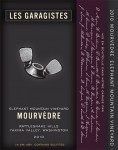
… including our first Mourvèdre (and Grenache, come to think of it)!
2010 Peugeot Blending Trials: the components
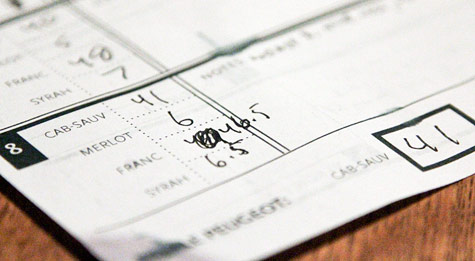
After a disciplined night of ascetic, scientific rigor (and, uh, drinking), we have an official blend for our 2010 Peugeot. Here’s the thrill-packed, edge-of-your-seats story of how it all went down, in the two phases we went through it: assess the components, then concoct the blend.
Boy, does that sound like exciting reading or what?! Yeah? Okay, then: life insurance paid up? Great. Grab your micrometer and follow me…
The Components
As always, we began by tasting the components, beginning with the Cab Sauv. Still very young — definitely in need of one more racking — but firm and substantial. As I’ve noted before, this vintage gave us a huge gift of higher acidity, in this case putting all the complex flavors (black raspberry, dark cherries, even a hint of peach) into high-def.
From the first taste, it was clear the Merlot — never a huge component of the Peugeot — was destined for an even smaller role than normal. While the basic outlines of its Merlot-ness were fine, leaving it too long in new half barrel had rendered it way too woody to use in any quantity. Again, I think a hard racking will help, but this probably won’t be Merlot’s year to snatch the Oscar, that’s for sure.
Then the Franc. Always the defining cornerstone of the Peugeot, and this year, it’s absolutely fantastic. A lovely, floral (from stem to blossom) nose, beautiful and elegant in the mouth, lingering lovingly over a long finish. Again, the acidity of the vintage plays right into the Franc’s hand, balancing the depth of fruit we get from Elephant Mountain Vineyard with a vividness that takes you out of your glass and into a summer field in the Loire.
Lastly, the Syrah. We discovered that some of the ethyl acetate that’s apparently plagued a lot of winemakers this year (think fingernail polish) had snuck back into the Syrah, so we’ll be carpet bombing this sucker with sulfite, and stat. But after the EA blew off, the wine’s true nature unfurled, with lovely deep fruit and a hint of licorice. Last year was the first time we added Syrah into the Peug, so provided we can 86 the EA, it’ll definitely have a cameo this year, too.
Next, the scintillating blending trials themselves…
No commentsViognier? Safely in bottle.
ikoni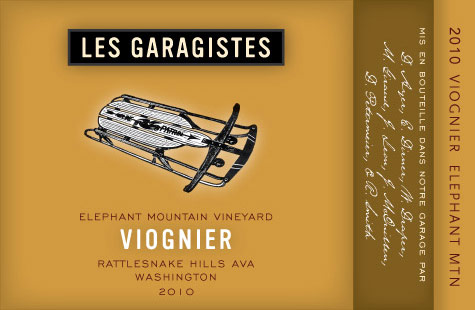 Eight cases plus eight bottles. 3.06 pH (hey, at least it’s better than 3.01, which it was a couple of weeks ago) — vivid! Lovely, floral nose, though probably goom-bah’d by a little too much oak at the moment. 25ppm sulfite at bottling. We’ll let it sleep until next summer and hope it unfurls.
Eight cases plus eight bottles. 3.06 pH (hey, at least it’s better than 3.01, which it was a couple of weeks ago) — vivid! Lovely, floral nose, though probably goom-bah’d by a little too much oak at the moment. 25ppm sulfite at bottling. We’ll let it sleep until next summer and hope it unfurls.
Update 2010: The Troubled Ones II
 Our Viognier may yet have a Hollywood ending. Our Rosé, well… by any other name, would taste as sweet…
Our Viognier may yet have a Hollywood ending. Our Rosé, well… by any other name, would taste as sweet…
Rosé
Our Rosé was a tank bleed (or “seignée”) of the Grenache right after it was crushed. I confess this one totally drank my lunch, tossing a number of problems at me I had no answers for. The biggest was thinking I was watching a nice, slow fermentation through the fall, then winter… then spring… when in fact primary fermentation had collapsed short of the goal and what I was actually seeing was malolactic fermentation (a secondary, bacteriological fermentation that changes malic acid into lactic acid). As a result, I didn’t realize this wine was “stuck” — not completely fermented and stalled in a sticky, quasi-alcoholic stasis — until a month or so ago.
Restarting a stuck ferment is notoriously hard, because you’re asking the yeast to start from a dead stop in an environment mostly toxic with alcohol (again, the ferment has nearly converted all the sugar to alcohol at this point, so the wine is pretty poisonous stuff as far as yeast is concerned). So I went through the laborious and time-consuming protocol recommended by the good folks at Scott Labs. It involves multiple nutrient additions over the course of a few days, then gradually adding waves of yeast over the course of an afternoon so they methodically gain confidence and territory without freaking out. In extreme cases, the protocol also calls for standing on one foot, baying at the moon, and whacking yourself with a switch.
Okay, those last three aren’t exactly in Scott Labs’ protocol, but I do think they helped in this case. One of the carboys actually finished, so now we need to decide if we should just blend the two together (the other is about 1% residual sugar), filter it, and call it a lesson learned; or figure out how to get the other one to finish.
Frankly, I’m ready to clear the decks, if only because the last thing I want to be doing in September as grapes arrive is pleading with a grumpy rosé. So I think we’ll probably just bottle it in the dark of some night and walk away, whistling innocently. It does still smell pretty decent behind all the yeast, so if we filter then blend the 1% and the nearly-none-percent carboys, we’ll have a wine that may be a tad sweet, but with luck, come off as “fruity” when chilled into restraint.
Here’s hoping…
No comments